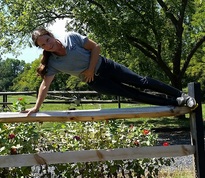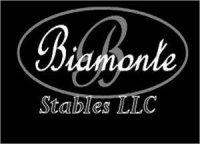
Show season is winding down here in SE Pennsylvania. It’s the time of year when we start to think about putting pajamas on the horses at night, and should we clip. As we move into winter our thoughts go to teaching our equine athletes new things that they can show off next show season! We start to work on whatever is next for our horse to learn: changes, better balance, getting suppler, being less on the forehand, staying steadier around a course.
We work on our horses’ fitness as well. Riders typically expect their horses to be at the top of their game physically. Can your horse expect the same from you??? What are you doing to stay riding fit? It should be fit to ride, not ride to be fit!
You want your horse at proper weight, but are you? Did you know that the experts say that a horse should not carry more than 20% of its body weight in equipment and rider? For a 1000 pound horse, that means the saddle, bridle and whatever other tack you are using, plus you, should not weight more than 200 pounds. Apparently, carrying more than that is bad for them and can cause injury over time. Lots of riders don’t know that, have never given it a thought, or have never done the math. It’s something I have to think about all the time with regards to my lesson horses. I am always considering rider weight and my horses.
More than our weight, what about our fitness level as riders? Watching riding lessons you hear things like this all the time: ride more with your seat; you need a stronger core; quiet the hands; hold your position; stay more organized in your body, stop gripping with your leg, and many other things.
I know I have said things like that thousands of times! As an instructor I was limited to only being able to help my riders while they were in the saddle. Much of the work needed to have quieter hands, a stronger core, and a better seat comes from the time out of the saddle. It was up to my students to figure it out once they went home. Ya know what, most of them didn’t. So the lessons went on the same way, over and over and over.
NOW I can actually help the rider in AND out of the saddle. << insert Angels singing ;-)>> Now when I say you need a stronger core it doesn’t end there. I have a program I can hand them, that if they do it, they will have a stronger core and lots of other progress in the saddle. Those riders are able to find and activate muscles now that they couldn’t before, like those upper abdominal muscles that are so important. Those riders have better strength in the muscles needed for riding, like their back muscles between their shoulder blades. Those riders are now stronger, more fit and therefore are able to use their bodies more efficiently in the saddle so they not only ride better, they can ride with less effort and for longer.
It’s been fun to watch from the instructor’s seat! It started with one client who asked me what I was doing to stay in shape. First that client started using the program. Then as another rider saw what a difference it made, she started using it. Then a 3rd rider saw the 2nd rider improving rapidly and decided she needed to do it. Now when they arrive for their lesson all they can talk about with each other initially is how they are doing in their workouts. How they are getting stronger and more flexible. They are super excited to try out these new bodies on the horse. They laugh about what a difference it has made. They also tell me how they are fitting into dresses and pants they haven’t worn in years as their body shape changes, sometimes even though they aren’t losing weight. Others are losing the weight they have always wanted to lose. There is a big smile for those victories as well.
I love that I can now share this simple workout and meal plan with fellow riders as well as help keep them motivated with the fitness accountability group! Being their fitness coach is just an extension of being their riding coach. It’s fun to watch them interact and support each other in the group. It’s fun to see them celebrating each others successes as well as giving advice and being encouraging when one of them is struggling. They keep me on track to! On those days I just don’t feel like working out, I just check in with the group and they give me the nudge I need to keep going! When I need a new healthy chicken recipe for dinner, I ask the group. Poof, recipes appear!
It’s not just the riders that have benefited from this. The horses are so much happier! It’s is easier for them to carry this fit rider! The rider is holding their body in place and balancing themselves better so the horse is not needing to do it. Now the horse can just focus on his job, not the riders unbalance!
It’s a win, win, win! The riders are riding better, progressing and having more fun. The horses are happier. The riding instructor feels less like a broken record and gets to do more fun, interesting and challenging things with their riders!
All this started because I decided to lose weight and get in better shape. I am so happy I did.
If you would like more information or would like to join our Fitness Accountability Group, just let me know! We are not an exclusive club! You don’t have to ride at our barn. You just have to want to improve, and to commit to wanting to eat healthier and get regular exercise!
Remember, life’s a journey…enjoy the ride!
We work on our horses’ fitness as well. Riders typically expect their horses to be at the top of their game physically. Can your horse expect the same from you??? What are you doing to stay riding fit? It should be fit to ride, not ride to be fit!
You want your horse at proper weight, but are you? Did you know that the experts say that a horse should not carry more than 20% of its body weight in equipment and rider? For a 1000 pound horse, that means the saddle, bridle and whatever other tack you are using, plus you, should not weight more than 200 pounds. Apparently, carrying more than that is bad for them and can cause injury over time. Lots of riders don’t know that, have never given it a thought, or have never done the math. It’s something I have to think about all the time with regards to my lesson horses. I am always considering rider weight and my horses.
More than our weight, what about our fitness level as riders? Watching riding lessons you hear things like this all the time: ride more with your seat; you need a stronger core; quiet the hands; hold your position; stay more organized in your body, stop gripping with your leg, and many other things.
I know I have said things like that thousands of times! As an instructor I was limited to only being able to help my riders while they were in the saddle. Much of the work needed to have quieter hands, a stronger core, and a better seat comes from the time out of the saddle. It was up to my students to figure it out once they went home. Ya know what, most of them didn’t. So the lessons went on the same way, over and over and over.
NOW I can actually help the rider in AND out of the saddle. << insert Angels singing ;-)>> Now when I say you need a stronger core it doesn’t end there. I have a program I can hand them, that if they do it, they will have a stronger core and lots of other progress in the saddle. Those riders are able to find and activate muscles now that they couldn’t before, like those upper abdominal muscles that are so important. Those riders have better strength in the muscles needed for riding, like their back muscles between their shoulder blades. Those riders are now stronger, more fit and therefore are able to use their bodies more efficiently in the saddle so they not only ride better, they can ride with less effort and for longer.
It’s been fun to watch from the instructor’s seat! It started with one client who asked me what I was doing to stay in shape. First that client started using the program. Then as another rider saw what a difference it made, she started using it. Then a 3rd rider saw the 2nd rider improving rapidly and decided she needed to do it. Now when they arrive for their lesson all they can talk about with each other initially is how they are doing in their workouts. How they are getting stronger and more flexible. They are super excited to try out these new bodies on the horse. They laugh about what a difference it has made. They also tell me how they are fitting into dresses and pants they haven’t worn in years as their body shape changes, sometimes even though they aren’t losing weight. Others are losing the weight they have always wanted to lose. There is a big smile for those victories as well.
I love that I can now share this simple workout and meal plan with fellow riders as well as help keep them motivated with the fitness accountability group! Being their fitness coach is just an extension of being their riding coach. It’s fun to watch them interact and support each other in the group. It’s fun to see them celebrating each others successes as well as giving advice and being encouraging when one of them is struggling. They keep me on track to! On those days I just don’t feel like working out, I just check in with the group and they give me the nudge I need to keep going! When I need a new healthy chicken recipe for dinner, I ask the group. Poof, recipes appear!
It’s not just the riders that have benefited from this. The horses are so much happier! It’s is easier for them to carry this fit rider! The rider is holding their body in place and balancing themselves better so the horse is not needing to do it. Now the horse can just focus on his job, not the riders unbalance!
It’s a win, win, win! The riders are riding better, progressing and having more fun. The horses are happier. The riding instructor feels less like a broken record and gets to do more fun, interesting and challenging things with their riders!
All this started because I decided to lose weight and get in better shape. I am so happy I did.
If you would like more information or would like to join our Fitness Accountability Group, just let me know! We are not an exclusive club! You don’t have to ride at our barn. You just have to want to improve, and to commit to wanting to eat healthier and get regular exercise!
Remember, life’s a journey…enjoy the ride!

 RSS Feed
RSS Feed

